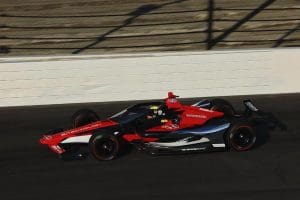MOORESVILLE, N.C. — The competition debut of IndyCar’s Hybrid Era will have to wait a little longer.
The much-anticipated Hybrid Assist Unit was scheduled to be raced for the first time when the NTT IndyCar Series opens its season March 10 with the Firestone Grand Prix of St. Petersburg.
Although IndyCar believes it has proven the concept of the device, supply-chain issues have forced the project to be delayed until after the 108th Indianapolis 500 — at the earliest.
It was originally supposed to be paired with a more robust 2.4-liter engine, but on Dec. 6, 2022, the series abandoned that powerplant and announced it would pair the kinetic energy, power rejuvenation unit with the current 2.2-liter engine.

One year and one day later, IndyCar announced the Hybrid Assist Unit would not be on the starting grid for the first three months of the season.
“It’s not done, even if lots has been done,” Penske Entertainment President Mark Miles told SPEED SPORT. “The last thing we want to do is put it in a race and not have it up to snuff. We have to get it right.”
Miles said it would have been great if the unit had been ready for St. Petersburg, but missing the deadline is not the end of the world.
“The most important thing is when it is introduced it is reliable and will improve our racing,” Miles said. “It has to be dependable, and it is going to deliver more horsepower. I think it is pretty clear how it will be used and will give the driver more options.
“Every new development comes with risks. Changes comes with risks. Technical development comes with risks. Everything gets better over time.”
The project remains IndyCar’s priority for 2024.
“We are committed to the hybrid and its development. It’s not done yet,” Miles said. “The introduction of it in racing isn’t done yet and that is the priority. We need to get that done before we start talking about what is next with the car. It’s next and it needs to be our focus.”
Miles emphasized the reason for IndyCar’s delayed implementation of the Hybrid Assist Unit has to do with making sure the same parts are available to all teams at the same time.
“With respect to the hybrid, our view is that we believe all the work that has been done so far, including the 15,000 miles of testing on track and God knows how many hours on the dyno, for our purposes has proven the technology works,” Miles said. “The vast majority of the testing has been on prototype parts. Those are the steps to make sure the technology works.
“The issue that has caused this delay has to do with production parts,” Miles added. “We have continued to get information that made us not confident and not certain that we could get adequate production parts on some of the parts at scale so they could all be tested and in the hands of the team so they could make it to St. Petersburg.
“If we couldn’t make St. Pete, we were not going to take any risks with the Indianapolis 500, we would push the debut to after. From our view, we want it understood that this system is going to work; we just have to now produce it at scale.”
On Dec. 7, IndyCar announced the Hybrid Assist Unit, a first for the IndyCar Series, would be delayed until midway through the season.
That set off a flurry of speculation that the system wouldn’t work. Miles scoffed at those reports.
“Prototypes have proved it to us with the technology,” he said. “Now, it’s about production. I don’t read social media. What I care about is the people that understand things and have this perspective.”
Miles was asked if this was a case of, “better safe than sorry,” instead of rushing out parts that may not meet the necessary supply for the 27 full-time entries expected in 2024.
“Of course,” he responded.
Miles said much work has been done to the current IndyCar chassis that makes it lighter. Because of that, there will be a benefit in terms of speed even before the Hybrid Assist Unit is utilized later in the season.
“We have great racing,” Miles said. “We’ve done things to make the car lighter for the hybrid system. We are going to go out there and race a few races including the Indianapolis 500 with the lighter car without the Hybrid and guess what is going to happen?
“It’s going to go faster,” Miles continued. “When you add the Hybrid, there will be related weight. But once incidental fans can see an unintended consequence of a lighter car without adding the Hybrid yet will be less weight for the existing engine. Interesting.”
Perhaps, but it is one more disappointment for the IndyCar Series and another delay in preparing for the future.
This story appeared in the Dec 20, 2023 edition of the SPEED SPORT Insider.

